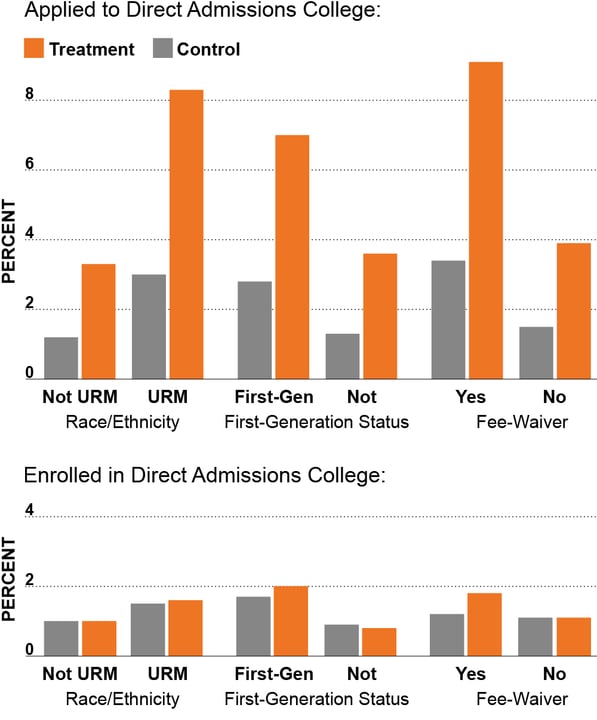You have /5 articles left.
Sign up for a free account or log in.

Photo illustration by Justin Morrison/Inside Higher Ed | Rawpixel | Getty Images
Students offered direct admission to college were 12 percent more likely to apply to a postsecondary institution but no more likely than those who applied through traditional channels to enroll, according to a new large-scale study released Tuesday.
Jennifer Delaney, a professor of higher education at the University of Illinois at Urbana-Champaign and one of the study’s authors, said the findings—which are “fairly consistent” with previous, smaller-scale studies—underscore the benefit of direction admission as a “lighter-touch” intervention in promoting college attendance.
“It is effective in moving things, but it’s not a silver bullet in solving everything in terms of advancing equity, increasing access, and then on the enrollment end, it’s not touching that so much,” she said. “But it’s also not intervening at that part of the process.”
Direct admissions—the practice of proactively guaranteeing college admission to high school seniors based on existing data such as grades or test scores—has been touted as a promising way to boost both flagging higher ed enrollments and postsecondary degree attainment, especially among underrepresented minority, first-generation and low-income students. It reduces barriers to college by eliminating the need for a student to fill out a full application and waiving the application fee. At least nine states and hundreds of institutions now use some form of direct admissions.
The new study, which looked at nearly 32,000 students for the 2021–22 academic year, used Common App data to determine the impact of direct admissions on application and enrollment outcomes. Researchers randomly assigned students who had created a Common App profile either to receive a direct admissions offer and application fee waiver or to be part of the “business as usual” control group. Six higher ed institutions—a mix of public and private, and varying in size and location—participated, setting their own GPA threshold for automatic admission somewhere between 2.5 and 3.3.
The results showed that students who received direct admission offers were nearly twice as likely as those who didn’t to apply to the institution that made the offer and 2.7 percentage points more likely to apply to any college or university. They responded most enthusiastically to offers from larger, higher quality institutions.
The outcomes were especially significant for members of underrepresented minority groups, who were between three and six percentage points more likely to submit a college application, first-generation students (four percentage points more likely) and low-income students (five percentage points).
But those applications did not translate into higher rates of enrollment. Using data from the National Student Clearinghouse, the researchers found that roughly 86 percent of all students in the study’s cohort who submitted applications enrolled at any institution. Among the directly admitted students who enrolled, there was no statistical difference in whether they enrolled in the partner institution or another one.
The one caveat, the study noted, was that the researchers found “a statistically significant but practically meaningless increase (0.93 percentage points) in the likelihood that a fee-waiver eligible student enrolls in the direct admissions college following treatment.”
Direct admission “is still not sufficient to yield positive impacts on college enrollment,” the study said. “Affordability constraints represent a growing barrier to college access, and direct admissions is not a replacement for financial aid … We show that guaranteeing admission rather than guaranteeing aid conditional on admission in a lower-cost strategy can still yield positive but not equivalent effects.”

Students offered direct admission were much more likely to apply to the institution that offered it, but the applications didn't translate into enrollment.
Graphic by Justin Morrison/Inside Higher Ed | Data: "Experimental Evidence on 'Direct Admissions' From Four States: Impacts on College Application and Enrollment," by Taylor Odle and Jennifer Delaney
Alan Byrd, dean of admissions at George Mason University in Virginia, noted in a press briefing that his institution participated in the study and had 200 students accept the offer of direct admission.
“The direct admission offer made them feel wanted,” he said. “It removed the stress and anxiety about applying and really presented Mason as a viable option to them.”
Ultimately, 32 students enrolled, he said. For those who didn’t, cost remained the biggest obstacle.
“We had quite a few students who deposited, who committed to us, but when they received their bills in July, they realized that Mason wasn’t affordable for them,” he said. “Even after taking out the max of student loans, they still had a pretty significant gap with us.”
Delaney said direct admission frees up both students and institutions to focus on other things.
“You don’t have to guess if you’re going to be admitted or fill out an application; you already know that you’re in,” she said. “So then it becomes, where do I want to go? Students are thinking about fit and choice. And institutions should be thinking about yield, which puts pressure on them to think about things like financial aid. How do we think about aid to enhance enrollment? How do we think about summer melt?”
For Mary Churchill, director of the higher education administration program at Boston University (and a regular contributor to Inside Higher Ed), the new study doesn’t go far enough, given that it only looks at four-year institutions—not community colleges. She believes that the use of proactive, streamlined admissions practices will continue to expand.
“Direct admissions are the future—especially for nonselective institutions,” she said. “For every student out there, there are a set of institutions where you can get in. Many states now offer free community college. The biggest advantage of direct admission is the demystification of the application process, and for the population that wasn’t already planning to apply to college, it’s a life-changing moment. Because they now know that it’s a possibility in their future.”








